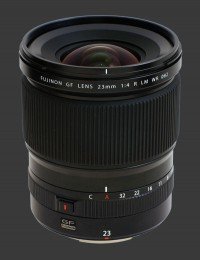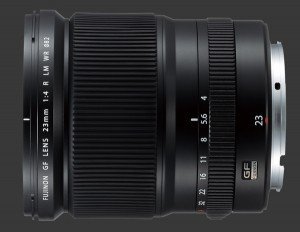Fujinon GF 23mm F/4R LM WR Review
Fujinon GF 23mm F/4R LM WR
The Fujifilm Fujinon GF23mm F/4R LM WR
Fujifilm Fujinon GF23mm F/4R LM WR is an ultra-wide prime lens for GFX system mirrorless cameras. Its 23mm focal-length provides a 100° field-of-view, comparable to an 18mm lens on a full-frame. This is the only ultra-wide GF-mount lens so far. It is most suitable for photographing architecture, interiors and sweeping landscapes.
This ultra-wide lens has a minimum focus distance of 38cm which gives it a maximum magnification near 0.1X. Inside, it features a rounded aperture made of 9 blades to make bokeh look smooth. Given such wide field-of-view, depth-of-field never becomes shallow.

Body Design
Medium Format lenses are necessarily larger and heavier than their Full-Frame counterparts. The GF 23mm F/4R LM WR weighs in at a hefty 845g, making it feel heavy in hand. It measures 90mm in diameter and 103mm in length. Unlike an ultra-wide lens for a smaller sensor though, this one does not require such a bulbous front lens element which lets it accommodate 82mm filters. Its maximum aperture of F/4 is common for ultra-wide lenses and is highly suitable for their typical subjects. It can be stopped down to F/32 which is seriously beyond the diffraction limit of the Fuji GFX-50S.
The body of the Fujifilm Fujinon GF23mm F/4R LM WR
Fujifilm Fujinon GF23mm F/4R LM WR is made of metal with a metal GF-mount, just like every other GFX system lens so far. Like its siblings, the lens is weatherproof against rain, snow and humidity, while also being freezeproof to -10°C (14°F). This lens has an entirely internal design and does not change lens or rotate while focusing. As one would expect for such a high-end product, this lens is extremely solid.
There are two rings around the lens barrel. Close to the front element, a wide rubberized ring controls the focus-distance. This focus-ring is fly-by-wire, sending electric signals to the camera while the ring is being rotated. When the camera is ready to accept these signals, it changes the focus distance. There are two cases where this happens:
- The camera is in Manual Focus mode. Turning the ring in MF mode changes the focus distance.
- The AF+MF, usually known as Direct Manual Focus, setting is enabled and AF has locked.
This fly-by-wire system has a significant impact on usability. First, the focus-ring does nothing when the camera is off. Second, movement of the ring is not directly proportional to focus-distance. One must turn the ring more around close distances than far ones. The focus ring turns very smoothly with a slight resistance and does not have stops at either end of the focusing range.
The second ring, near the base of the lens, is just over 1cm wide and made of metal. It controls aperture. Fujifilm implemented a system to support every type of aperture control. The ring itself has markings in full-stops for apertures from F/4 to F/32. There are extremely soft detents at each 1/3-stop between markings. Beyond the F/32 marking, a red A indicates Automatic Aperture Control. With the ring set to A, the camera is either in Shutter Priority mode or in Program mode, depending whether the Shutter-Speed is set a a specific speed or Auto, respectively. A C position next to A indicates Control-Dial aperture control. When the ring is set to C, the aperture is controlled by an on-camera control-dial. This places the camera in either Aperture-Priority mode or Manual mode, depending on how the Shutter-Speed dial is set.
To avoid accidentally changing the camera mode, the aperture-ring cannot move freely between C, A and F/no positions. A small square button marked with a red line built into the aperture ring must be pressed to move the aperture-ring in a way that changes the Exposure Mode. All this seems complicated but it allows photographers to choose how to work with aperture.
Optical Performance
Fujifilm stated that it designed all its GFX lenses to be capable of resolving 100 megapixels. In the case of the 23mm F/4R, they also set out to minimize distortion using two aspherical lenses, one Super ED, and three ED lenses. The results are extremely impressive. There is some measurable barrel distortion left, less than a half percent, so it only gets barely noticeable for some subjects.
This lens exhibits some moderate vignetting wide-open, almost a full stop. Stopping down to F/5.6 reduces vignetting and it reaches its minimum starting at F/8. There remains a gradual darkening of corners which is easy to correct via image processing with virtually no negative impact on image quality. Once lens calibration profiles for the GF 23mm become available, this can be completely automated.
Color and contrast are impeccably rendered by the GF 23mm F/4. There are no signs of fringing or any other type of chromatic aberrations. This lens has been treated with the latest nano coatings to protect against ghosting and flare which appears to be very effective. Even with backlit subjects, contrast is well-maintained throughout the image.

Fujinon GF 23mm F/4R LM WR Sharpness
The Fujinon GF 23mm F/4R LM WR is very sharp. Center sharpness starts perfect right from wide-open and stays that way until diffraction hits around F/20. Medium format pixels are larger and so smaller apertures can be used before suffering from diffraction compared to full-frame and APS-C cameras. Extreme corners start off visibly soft at F/4. They sharpen nicely at F/5 and gain a little sharpness beyond that until peak around F/8. Again, diffraction hits at F/20.
What is shown below are 5 crops taken from a photograph, repeatedly captured for each combination of focal-length and aperture. The smaller pieces are cropped from the extreme corners of the image, while the middle wide crop comes from the center of the image. Select an aperture in a row for a desired focal-length to see the crops from the corresponding image. When judging quality, keep in mind that these crops come from a 50 MP image which is normally used to print an image up to 40x30". On a computer display, these may appear much larger which magnifies image defects.
The Fujifilm GF23mm F/4R LM WR is a benchmark for the GFX Medium Format System. It offers an extremely wide 100° angle-of-view which is highly suitable for architectural photography, sweeping landscapes and crowded spaces. Designing such an extremely wide rectilinear lens is quite difficult on any platform which is evident in the corner performance of the GF 23mm. There is visible softness and vignetting wide-open yet the remaining performance of this is lens is nearly impeccable. Sharpness in the center is simply spectacular and its optics manage to correct for distortion and aberrations almost perfectly. There is no doubt that the GF23mm is worthy of its price and that it delivers a solid performance as the flagship ultra-wide GF-mount lens.


Please Support Neocamera
All information on Neocamera is provided free of charge yet running this website is a huge endeavor. Purchases made via affiliate links found throughout the site help keep it running and up-to-date. There is no additional cost to you, so please consider buying via these links to our affilates:
If you found any information on this site valuable and did not purchase via our affiliate links, please considering donating via PayPal:
Any amount will be greatly appreaciated. Thank you for your support!
Updates
2024.11.18

Best 2024 Photography Gifts for Every Budget
Great gifts for photographers and photo enthusiasts selected for every budget among the best products of 2024.
2024.08.07

Eye Protection Tips for Professional Photographers
The four main considerations for professional photographers regarding eyewear.
2024.07.14

Fujifilm X100VI Review
Flagship fixed-lens compact digital camera with a 40 MP sensor and Image-Stabilization, a first for the series. Retro design featuring dual control-dials, plus direct ISO, Shutter-Speed and EC dials. Its hybrid viewfinder can switch between EVF and OVF mode.
2024.05.09

Fujifilm GFX100 II Review
Flagship 102 Megapixels Medium-Format Mirrorless Digital Camera with 8-Stop 5-Axis IBIS, 8 FPS Drive, 8K Video and 400 MP Super-Resolution capture in a weatherproof and freezeproof body with dual control-dials and dual memory-card slots.
2024.04.03

Fujifilm X-T5 Review
Newest Fujifilm flagship boasting a 40 MP APS-C sensor, 5-axis IBIS with 7-stop efficiency, 15 FPS continuous drive, 6.2K Video capture, dual control-dials and dual SDXC UHS-II slots in a sturdy weatherproof and freezeproof body.
2023.11.20

Best Digital Cameras of 2023
Find out which are the Best Digital Cameras of 2023. All the new Mirrorless Digital Cameras from entry-level to high-end professional.
2023.07.10

Fujifilm X-H2 Review
40 Megapixels APS-C Hybrid Mirrorless Digital Camera with 7-stop IBIS. Fastest shutter ever and 8K video capture. Large builtin EVF with 0.8X magnification and 5.8 MP, plus an Eye-Start Sensor. Packed with features and large number of controls in a weatherproof and freezeproof body.
2023.05.07

Sony FE 20-70mm F/4G Review
Review of the unique Sony FE 20-70mm F/4G lens. The optical zoom of this lens spans ultra-wide-angle and medium focal-length coverage, making it one of the most versatile Full-Frame lenses on the market.
2023.01.15

Huion Inspiroy Dial 2 Review
Review of the Huion Inspiroy Dial 2 tablet, a medium sized drawing surface with dual dials and customizable buttons. Connects via USB-C or Bluetooth 5.0 with Windows, Linux and Android support.
2022.12.08

How to Pack for a Photo Trip
Find out how to pack for a travel photography trip, carry your gear safely while meeting airline regulations.
2022.11.13

Best Digital Cameras of 2022
The best digital cameras of 2022. A short list of the most outstanding models in their respective categories. Choose one for yourself or as a gift.
2022.09.21

Pentax DA* 60-250mm F/4 SDM Review
Review of the Pentax DA* 60-250mm F/4 SDM, the constant-aperture telephoto zoom with the highest zoom-ratio on the market.
2024.11.18
2024.08.07
2024.07.14
2024.05.09
2024.04.03
2023.11.20
2023.07.10
2023.05.07
2023.01.15
2022.12.08
2022.11.13
2022.09.21
NEWS
2024.12.17

Venus Unveils 2 Tilt-Shift Macro Lenses
Lens
2024.12.17

Panasonic Lumix G97 and ZS99 Launched
Digital Camera
2024.11.19

Sony Unveils Their Brightest Zoom Lens
Lens
2024.11.19

Sony Finally Upgrades Alpha A1 Flagship Camera
Digital Camera
2024.11.12

New Laowa Slim Ultra-Wide Lens
Lens
2024.11.07

Hasselblad Adds XCD 75mm Lens
Lens
2024.11.07

Nikon Launches Z50 II
Digital Camera
2024.11.05

Venus Created Worlds First Shift Zoom Lens
Lens
2024.11.01

Nikon Announces Development of Standard Power-Zoom Lens
Lens
2024.10.30

Canon Launches 3D APS-C plus 3 Extra RF Lenses
Lens
2024.10.14

Fujifilm Extends APS-C Lineup
Digital Camera ○ Lens
2024.09.27

Leica Launches New Q3 with 43mm Lens
Digital Camera


















